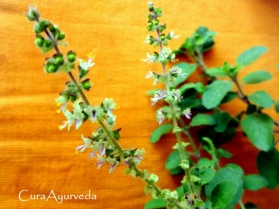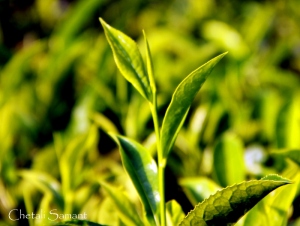Modern science is now exploring circumstances that change how genes are  regulated and expressed. A stressed depleted individual will transfer different gene tendencies than a healthy and happy parent. Āyurvedic teachings take new depth within the science of epigenetics.
regulated and expressed. A stressed depleted individual will transfer different gene tendencies than a healthy and happy parent. Āyurvedic teachings take new depth within the science of epigenetics.
The modern understanding of genetics started in 1866 by Gregor Mendel and his research only began to be fully understood around 1915. Today, much is understood on a biological level, but many mechanisms of genetics, such as transgenerational epigenetic inheritance, are still not fully understood and new research changes the models regularly.
Recent research is indicating that nutrition and other lifestyle factors have the ability to change how a gene expresses its various potentials. The health of the sperm is affected by the weeks prior to conceiving. The nourishment given to the foetus is based on the present health condition of the mother and the food she eats during pregnancy.
Caraka Saṁhitā talks about gene selection in the Śārīrasthāna:
The reproductive material of the [1] mother and [2] father, the [3] nourishment, and the [4] soul’s past actions are the four [factors] which all have four elements given to the foetus. The mother and father’s karma creates which of these becomes predominant to cause the looks of the child, along with the nature of the past existence. [II.26-27]
 Āyurveda is using four primary factors and taking into account the epigenetic impact of nutrition and the character of the incarnating soul. This makes sixteen factors, as each of the four sources has their particular four elemental (1) make up of which any of the sixteen parts can dominate and express themselves. It is interesting to note that Mendel worked with a chart of four parts, though it took only the mother and father’s genetics into account.
Āyurveda is using four primary factors and taking into account the epigenetic impact of nutrition and the character of the incarnating soul. This makes sixteen factors, as each of the four sources has their particular four elemental (1) make up of which any of the sixteen parts can dominate and express themselves. It is interesting to note that Mendel worked with a chart of four parts, though it took only the mother and father’s genetics into account.
Āyurveda says the ‘distinguishing strength’ of karma chooses which genes will express themselves. This is similar to Augustin Sageret’s concept of ‘dominance’, which explains how certain characteristics of a parent are more likely to appear in the offspring and ancestral characteristics not found in the parents can appear in the offspring.
Both my parents have brown eyes.
My paternal grandmother and maternal great grandmother had blue eyes. Āyurveda does not consider it chance that I received blue eyes, while my brothers both have brown eyes.
Āyurveda’s genetic philosophy takes into account both the physical, mental and spiritual components of gene determination and gene expression. Charaka discusses physical cleansing and tonifying before conceiving and the food and activities to create a healthy child [VIII.4]. The mental aspect is approached through visualization of the desired child and mantra. Charaka engages the spiritual component by recommending ritual (pūjā) to gain blessings, transform karma, and attract a good natured soul to support the highest potential gene transfer from the parents to the child.
All these aspects of gene transfer are supported or hindered by nutrition and situations during pregnancy. Modern research is now studying how epigenetic variations at the early stage of embryogenesis effects gene expression. Charaka mentions that the sounds heard by the mother during pregnancy will impact the mental disposition of the child.
The factors causing the mental disposition are explained in Śārīrasthāna,
The disposition of the mind which determines a soul’s regular actions are determined by [1] the mental disposition of the mother and father, [2] that which is heard repeatedly by the pregnant woman, [3] that arising from the soul, and the [4] the mental nature of the soul’s past habits/practices.[VIII.16]
The soul that enters at the time of fertilization plays a crucial role in the physical and mental nature of the child a couple will create. The couple may be healthy, cleansed and toned and play spiritual music the whole pregnancy, but this is only half of what creates the nature of the child.
We get what our karma creates.
In Vedic Astrology, the nature of one’s children is related to the nature of one’s consciousness (chitta) seen in the fifth house. We are creating what our mind dwells upon, in our life and in our children. What one is continually thinking about is indicative of the nature of the child they will create.
The Śārīrasthāna of Caraka Saṁhitā says,
A woman produces a child that resembles her thoughts during embryogenesis. [II.25b]
A woman (strī) produces (prasūtā) a child (jantu) that resembles (sadṛśa) her thoughts/inclinations/mood/mind (manas) during the production (upapatti) of the foetus (garbha) (2).
The mental state during the time period of conception (3) and during the pregnancy impacts the nature of the soul that incarnates into the womb. Modern epigenetic research would say that stress measured by cortisol levels impacts gene expression in the early stage of embryogenesis. Either way it is said, it’s important to be calm, happy and centered when creating a child. It is not only the moment of copulation, but the spiritual, mental, emotional, and physical landscape before and during the creation of a child that influences it’s nature.
The soul which enters the womb is attracted by the resonance of the parent’s mind with the resonance of the soul’s past actions.
The practice given by Charaka is for the mother to visualize the desired child and eat, dress and live in the way that represents the culture wanted in the nature of the child [VIII. 10-14]. This lifestyle supports the visualization and is aimed at attracting a soul desired by the parents.
The child of musicians is more likely to be a musician because the parents were more likely to be in the resonance of music while attracting a soul, conceiving and pregnancy. But if there were financial stresses and the parent’s minds were more focused on MAKING MONEY , then they happen to birth a little financial analyst instead. In this way, the thoughts and desires arising from the past karmas of the parents attracts a soul of like nature.
, then they happen to birth a little financial analyst instead. In this way, the thoughts and desires arising from the past karmas of the parents attracts a soul of like nature.
Our mindfield (chitta) and the desires growing there show what springs forth from us, in our life and in our offspring. Presently, it is popular in India to try and control the child’s destiny by a caesarean birth with an astrologer’s date and time. But a caesarean birth has its own issues in the imprinting of the consciousness.
Everything in our life is just a reflection of our own growth and consciousness – therefore we must clean the dirt from ourselves not from the mirror. The real recipe for an incredible child is the inner cultivation of ourselves.
Notes:
(1) Śārīrasthāna II.31 states the transmigrating soul carries the four elements (earth, water, fire, air), and moves according to its past actions (karma-atmakatva). The next few verses elaborate more on this topic.
(2) This verse has often been taken to mean that the child looks like what a woman is thinking at the exact moment of ‘copulation’ leading to conception. There are two words often used to refer to conception; niṣeka which means ejaculation and ādhāna which means placing, depositing which is often associated more with fertilization. The term used in this verse is garbha-upapatti which literally means production of the foetus. This can be interpreted as the time period when the parents are working towards conceiving a child as well as conception and the time period while the foetus is growing in the womb.
(3) The semantics of the English term ‘conception’ is debated and not used in scientific literature as it does not differentiate: the fertilization of the ovum (sperm meeting egg) or the merging of the sperm’s nucleus with the egg’s to make a zygote (taking about 30 hours), or the implantation of the resulting cell mass (blastocyst) onto the wall of the uterus (1-2 days later).
 It is the smallest among citrus fruits yet contains more health benefiting nutrients than oranges . Available in all seasons and grown worldwide – its usage as a scrub for enhancing beauty , as a toxin remover when consumed internally in various forms and recipes is well known . A multi-purpose fruit and medicinal herb.
It is the smallest among citrus fruits yet contains more health benefiting nutrients than oranges . Available in all seasons and grown worldwide – its usage as a scrub for enhancing beauty , as a toxin remover when consumed internally in various forms and recipes is well known . A multi-purpose fruit and medicinal herb.

 by its weight reducing, cancer preventing and acne free beautiful skin giving (and several other) benefits.
by its weight reducing, cancer preventing and acne free beautiful skin giving (and several other) benefits.
 regulated and expressed. A stressed depleted individual will transfer different gene tendencies than a healthy and happy parent. Āyurvedic teachings take new depth within the science of epigenetics.
regulated and expressed. A stressed depleted individual will transfer different gene tendencies than a healthy and happy parent. Āyurvedic teachings take new depth within the science of epigenetics. Āyurveda is using four primary factors and taking into account the epigenetic impact of nutrition and the character of the incarnating soul. This makes sixteen factors, as each of the four sources has their particular four elemental (1) make up of which any of the sixteen parts can dominate and express themselves. It is interesting to note that Mendel worked with a chart of four parts, though it took only the mother and father’s genetics into account.
Āyurveda is using four primary factors and taking into account the epigenetic impact of nutrition and the character of the incarnating soul. This makes sixteen factors, as each of the four sources has their particular four elemental (1) make up of which any of the sixteen parts can dominate and express themselves. It is interesting to note that Mendel worked with a chart of four parts, though it took only the mother and father’s genetics into account.

 This ancestral root is recommended for colds, coughs, flu, indigestion, vomiting, belching, abdominal pains, motion sickness, laryngitis, arthritis, hemorrhoids, headaches, impotence, diarrhea, heart diseases and memory loss, and it can be taken as food or tea, a gargle and a compress, and also as a message oil.
This ancestral root is recommended for colds, coughs, flu, indigestion, vomiting, belching, abdominal pains, motion sickness, laryngitis, arthritis, hemorrhoids, headaches, impotence, diarrhea, heart diseases and memory loss, and it can be taken as food or tea, a gargle and a compress, and also as a message oil.